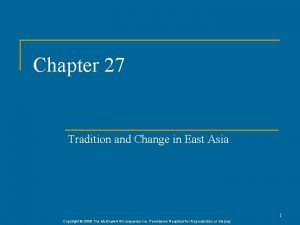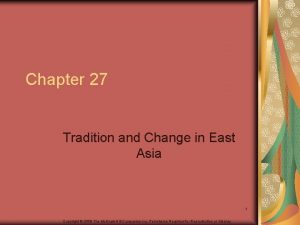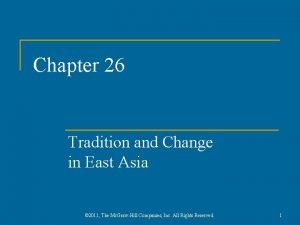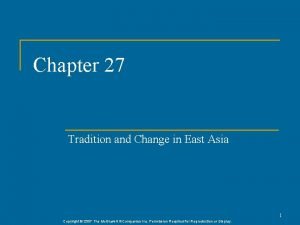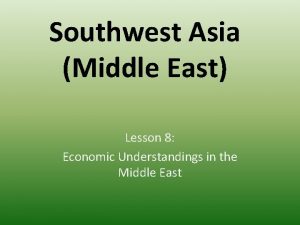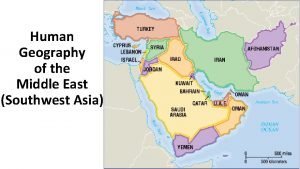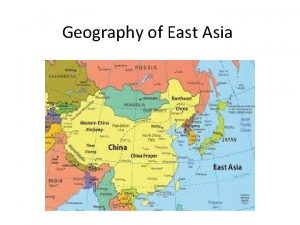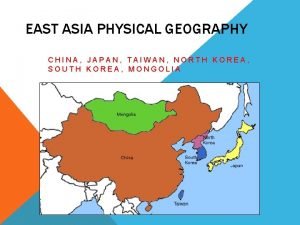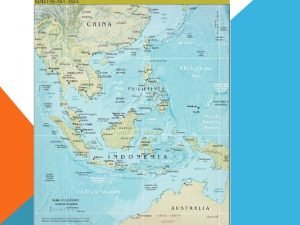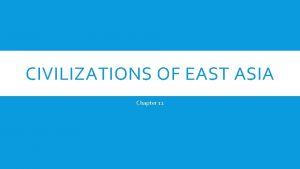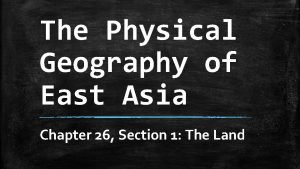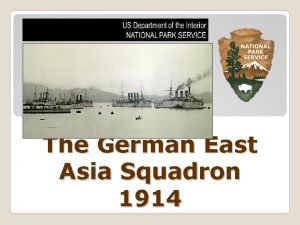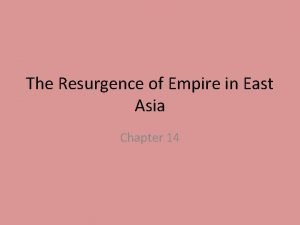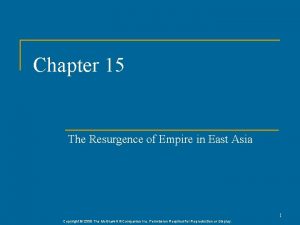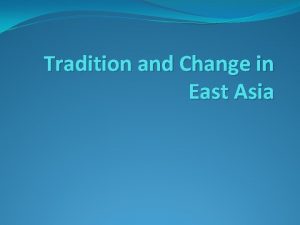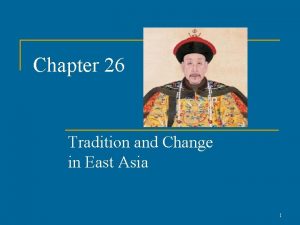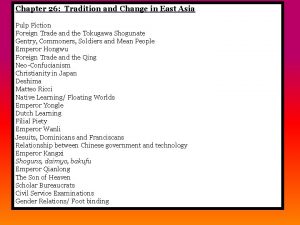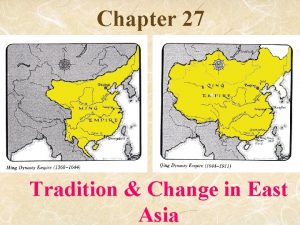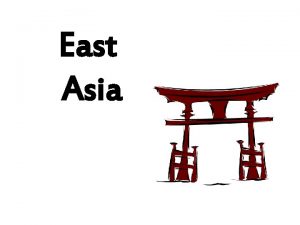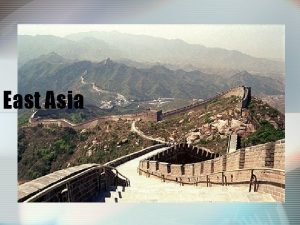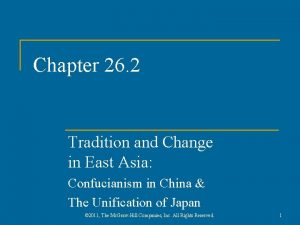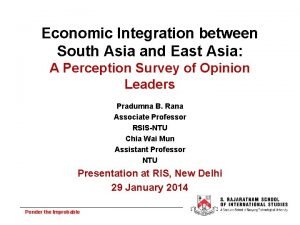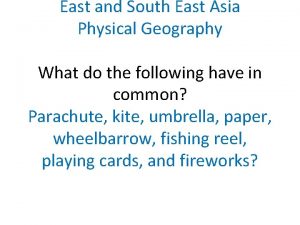TRADITION AND CHANGE IN EAST ASIA CH 26

















- Slides: 17

TRADITION AND CHANGE IN EAST ASIA CH. 26

The Quest for Political Stability

Ming Gov’t • Yuan falls and Ming Restored by Hongwu • Tightly centralized • Use of Mandarin & eunuchs • Prevent invasions Move capital from Nanjing to Beijing • Ineffective to Mongol Invasions The Great Wall • Built by the Ming Dynasty • Fortification against Northern invaders • Ming wanted to Eradicate any Mongol or Foreign influence (names, Dress) • Restore Chinese tradition (Confucian) Ming Decline & Collapse • Problems weaken society (Pirates, smugglers, ineffective defense, inept gov’t) • Famine • Disorganized gov’t • Manchu invasions

The Manchus • Qing “pure” • Nurachi unifies Manchus • Creates laws and Powerful military • Dynasty est. through Military and Chinese support (corruption, despised eunuchs) • Preserved their own cultural Identity Kangxi and His Reign • Effective Leader • Confucian scholar (wanted to implement Confucian policy) • Conqueror (Taiwain Where Ming loyalists Retreated) Grandson takes over Qianlong and his Reign • Height of Qing dyansty • 4 x he canceled taxes • Wealthy & well organized • Toward the end he Reign paid little attention To gov’t affairs. • Eunuch handle gov’t

The Son of Heaven • Human being designated By heavenly power to Maintain order on Earth. • Activities choreographed • Kowtow Scholar Bureaucrats • Day to day governance • Degrees earned by Civil service exam • Prep started at early age • By 11 -12 learned 1000 s Or characters Civil Service Examination System & Ch Society • Tests at the district, Provincial and metropolitan Levels • 300 pass metro. Exam • Taken several times • 3 days 2 nights writing “eight legged essays” posed By examiners • Highly competitive • Passing does not guarantee Position • CSE opens doors, social Mobility • Open to all males

Economic and Social Classes

Filial Piety • Duties of children to Fathers, but larger scale • Chinese family was Hierarchical, patriarchal, And authoritarian • Ancestor veneration Supports patriarchy • Filial piety cornerstone Of family values • Clans develop support Needs beyond nuclear family (local order, economies, Provisions) Gender Relations • Women under men • Boys preferred over Girls • Girls are a liability, At times performed Infanticide • Widows discouraged To remarry • Honor to commit suicide To follow husband’s to the grave Foot Binding • Originated in Song Dynas • Did not support woman’s Weight • Seen in wealthy classes • Sometimes in commoners To enhance social standing • Marriage contractual, Extend male lineage • Women could not divorce

American Food Crops & Population Growth • American maize, Sweet potatoes and Peanuts • Increase food supply Leads to more population Growth • Growth leads to social & economic problems • Can’t keep pace w/ Population • Commercial market leads To opportunities for entrepenuers Foreign Trade • Global trade leads to Prosperity for China • Trade in Indian Ocean Basin, C. Asia and Europe • Few imports • Tight gov’t regulation • Zheng He’s expeditions Stopped by eunuchs, but Did not necessarily stop Trade • Gov’t did not allow large Commercial ventures Trade and Migration in SE Asia • Merchants work Individually or in partnerships • Prominent in Manila, VOC Colony of Batavia, Phillipinnes, Malaya, Thailand • Economy took over Technological innovation • Adopted European Weaponry (based off of old Chinese innovation) • Technological slow down Due to gov’t priorities • Gov’t favored politics & Social issues

• Scholar Bureaucrats And gentry at high positions At Chinese society • Much in common: came From gentry ranks, intermediaries between imperial Gov’t and local society, easily Identifiable, distinct clothing, Received favorable treatment • Privileged status • 3 classes: peasants, Artisans or workers, & Merchants • Confucian saw Peasants as honorable • Artisan & workers Employees of state or Gentry and merchant families • Bottom of Confucian Social hierarchy • Secretly gained support For their enterprises • Unlike Europe, Chinese Did not support merchants On a larger scale • Military forces were a necessary evil • Some mean people: servan Prostitutes, entertainers

The Confucian Tradition and New Cultural Influence

Confucian Education Popular Culture • Promoted Confucian Values • Provided funding for Chinese cultural traditions (encyclopedia) • Not all Chinese Read Confucian works • Preferred more Entertaining pastime Reading • Popular novels Popular Novels • Confucian scholars Looked down on the Novels • Little merit, tales about Horror, wonder, excitement • Offered reflection on Human affairs

Matteo Ricci • Prominent missionaries Were the Jesuits • Ricci tried to convert Chinese to Christianity • He was learned, diplomatic And well liked by Ming • Well versed in Chinese Culture • Helped correct mistakes In Chinese scientific thought (calendars, bronze cannons) Confucianism and Christianity • Tried to catch Chinese Interest through science & technology • Ultimate goal always To convert • Argued Chinese culture Similar to Christianity • Gained little converts due To Christian exclusivity End of the Jesuit Mission • Jesuits missions end Due to internal Disagreements • Other missionaries Complain about tolerance Of Chinese traditions • Though conversion is Unsuccessful cultural exchanges Were • Europe gave China science and Technology • China gave Europe rational thought & use of the Civil Service Exam

The Unification of Japan

Tokugawa Ieyasu • Powerful states emerge Uniting into a unified land • Ieyasu est. the Tokugawa Bakufu (tent gov’t) • Tokugawa shoguns aim To prevent civil war and Control daimyo (territorial Lords who ruled most of Japan) • Daimyo absolute rulers in Their land, functioning gov’t Control of Daimyo • Shoguns attempt to Control Daimyo • Instituted policies “alternate attendance” (families in Edo, every Other year in court) • Other policies enforce Control (marriage alliances, Controlled visits, construction Permits…) Control of Foreign Relation • Japan restricted foreign Relations for 200 years • Expelled Europeans from Japan and forbade any trading In the ports • Traded locally, however

Population Growth • Increased agriculture Leads to population Growth • Many practiced Population control to Maintain or raise The standard of living • Late marriages, contraception, Abortion • “thinning out the rice Shoots” (infanticide) Social Change • Ushered in peace leads warriors To take on new gov’t positions • Daimyo and samurai live Inexpensive lives, become indebted To rice brokers • Merchants, however, become wealthy • Wealth allowed social mobility

Neo-Confucianism in Japan • Japan like China also Follow Neo-Confucianism • Becomes ideology of bakufu Native Learning • Neo-Confucianism Did not dominate Intellectual life • Some sought to create A cultural identity Separate from Chinese Influence • “Native learning” Emphasized folk tradition, Shinto religion, superiority Over others, xenophobic Floating Worlds • Floating world essentially Areas to get away from Social responsibilities and rules Of social conduct • Pop culture was urban, Satirical, secular • New forms of drama: kabuki Theater (bawdy skits singing, Dancing, spectacle) and bunrak (puppet theater)

Christian Missions • Christians contribute to Japan • St. Francis Xavier saw Success in conversion • However, as “native Learning” was established This creates backlash • Fear European alliance With daimyo will lead to destabilization Anti-Christian Campaign • 1587 -1639 many decree The halt of Christian missionaries • Many called to denounce Their faith • Refusal eventually led to a Painful death Dutch Learning • Interactions with Dutch merchants Were the only way to Make contact with The outside world, “Dutch Learning” • European art influences Study of anatomy And botany in Japan
 Chapter 27 tradition and change in east asia
Chapter 27 tradition and change in east asia Chapter 27 tradition and change in east asia
Chapter 27 tradition and change in east asia Chapter 26 tradition and change in east asia
Chapter 26 tradition and change in east asia Chapter 27 tradition and change in east asia
Chapter 27 tradition and change in east asia Lesson 8 middle east and south asia
Lesson 8 middle east and south asia East is east and west is west
East is east and west is west Is middle east in asia
Is middle east in asia Oceania 1984 map
Oceania 1984 map Geography of asia
Geography of asia Physical geography east asia
Physical geography east asia Climate regions in east asia
Climate regions in east asia Civilizations of east asia chapter 11
Civilizations of east asia chapter 11 Chapter 27 section 1 landforms and resources
Chapter 27 section 1 landforms and resources Physical geography of east asia
Physical geography of east asia The commander of the german east asia squadron was
The commander of the german east asia squadron was Chapter 14 the resurgence of empire in east asia
Chapter 14 the resurgence of empire in east asia Ming china spice chart
Ming china spice chart Chapter 15 the resurgence of empire in east asia
Chapter 15 the resurgence of empire in east asia
